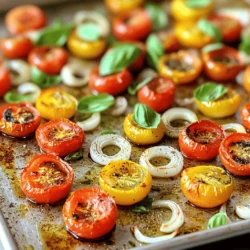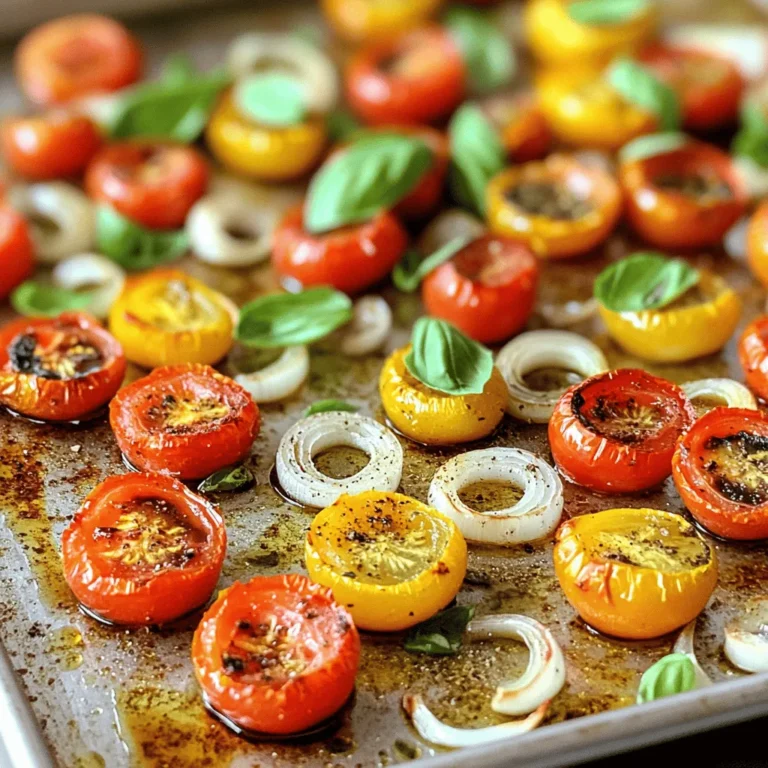Ready to elevate your pasta game? You can make your own homemade roasted tomato sauce—it’s simple, flavorful, and fresh! In this guide, I’ll show you how to select the best ingredients, roast your tomatoes to perfection, and blend them into a delicious sauce. Whether you’re looking to impress guests or enjoy a casual meal, this sauce will transform your dishes. Let’s dive in and unlock this kitchen secret together!
Ingredients
List of Ingredients
– Tomatoes: I prefer ripe Roma or heirloom tomatoes for their rich flavor. Choose firm, deep red tomatoes. Their sweetness shines when roasted.
– Onion and garlic essentials: Use one medium onion and six unpeeled garlic cloves. They add depth and aroma. Roasting brings out their natural sweetness.
– Olive oil and vinegar notes: Extra virgin olive oil is best for its fruity taste. A tablespoon of balsamic vinegar adds a hint of tang.
– Seasoning details: For seasoning, you need salt, black pepper, dried oregano, and dried basil. A teaspoon of sugar is optional. It balances acidity and enhances sweetness.
This combination of ingredients makes a flavorful sauce that truly delights.
Step-by-Step Instructions
Preheating the Oven
First, set your oven to 400°F (200°C). This high heat helps to caramelize the tomatoes and onions. Preheating is key for the best flavor.
Preparing the Tomato Mixture
In a large bowl, add 2 pounds of quartered tomatoes, 1 chopped onion, and 6 unpeeled garlic cloves. These fresh ingredients create a rich base for your sauce. Drizzle in 1/4 cup of extra virgin olive oil and 1 tablespoon of balsamic vinegar. Season with 1 teaspoon of salt, 1/2 teaspoon of black pepper, 1/2 teaspoon of dried oregano, and 1/2 teaspoon of dried basil. If you like a slightly sweeter taste, add 1 teaspoon of sugar. Mix everything well so the flavors blend.
Roasting Process
Spread the mixture evenly on a large baking sheet lined with parchment paper. Roast in the preheated oven for 30-35 minutes. Check until the tomatoes are caramelized and the onions are soft. This process brings out the natural sweetness and depth in each ingredient.
Blending the Sauce
After roasting, let the mixture cool for a few minutes. Squeeze the roasted garlic out of its skins and discard the skins. Transfer the roasted veggies to a blender. Blend until smooth or to your desired consistency. For a chunkier sauce, blend half and stir it back into the other half. This gives your sauce texture and richness. Adjust the seasoning if needed. You can now use this sauce on pasta, pizza, or store it for later.
Tips & Tricks
Perfecting Roasting Times
Roasting brings out a rich flavor in tomatoes. I suggest roasting for 30 to 35 minutes at 400°F. This time allows the tomatoes to caramelize nicely. Check for a soft texture and a slight browning. If you want a deeper flavor, leave them in a bit longer. Just watch closely to avoid burning.
Achieving Desired Consistency
To reach your perfect sauce texture, blend the roasted mix. For a smooth sauce, blend it all. If you prefer some chunks, blend half and stir it back in. This method gives a nice balance. You can also use a food mill for a unique texture. Adjust seasonings after blending to suit your taste.
Garnishing and Serving Suggestions
Garnishing adds a final touch to your sauce. Drizzle extra virgin olive oil on top before serving. Fresh basil leaves give a burst of color and flavor. For extra richness, sprinkle freshly grated Parmesan cheese. Serve it over pasta, as a pizza base, or store it in jars for later. You can really impress guests with a simple garnish!

Variations
Adding Extra Vegetables
You can easily boost your roasted tomato sauce with extra veggies. Try adding bell peppers, zucchini, or carrots. Chop them up and toss them in with the tomatoes. This adds flavor and nutrients. You can even use veggies that are in season for the best taste. Roasting these veggies with the tomatoes enhances their natural sweetness.
Spice Variations
If you want to change the flavor, play with spices. Instead of just oregano and basil, try thyme or rosemary. A pinch of red pepper flakes gives it a nice kick. For a smoky taste, add smoked paprika. Each spice brings a new twist, making your sauce unique.
Dietary Modifications
You can adapt this sauce for different diets. If you are vegan, it is already perfect! If you avoid oil, use vegetable broth to roast the veggies. For a low-sodium version, cut back on salt. You can also make this sauce gluten-free by serving it over rice or gluten-free pasta. Each option allows you to enjoy this sauce your way.
Feel free to explore these variations to make your homemade roasted tomato sauce truly your own.
Storage Info
Refrigeration Guidelines
After making your roasted tomato sauce, let it cool. Pour it into an airtight container. You can keep it in the fridge for up to one week. If you want to use it later, make sure to check the smell and look for any signs of spoilage before use.
Freezing for Long-Term Storage
Want to save some for later? Freezing works great! Pour the sauce into freezer-safe bags or containers. Make sure to leave some space for expansion. Label each bag with the date. Your sauce will stay fresh for up to six months in the freezer. To use, just thaw it in the fridge overnight.
Jarring Homemade Sauce
If you’re feeling ambitious, you can jar your sauce. Use clean, sterilized jars for best results. Fill the jars with sauce, leaving about half an inch at the top. Seal the jars tightly and store them in a cool, dark place. This method can help your sauce last for a year if done right. Just remember to use it within a week once opened.
FAQs
How to make homemade roasted tomato sauce?
To make homemade roasted tomato sauce, start with fresh tomatoes. I prefer using Roma or heirloom tomatoes. You will also need onion and garlic. Preheat your oven to 400°F (200°C). In a bowl, combine quartered tomatoes, chopped onion, and unpeeled garlic. Drizzle with extra virgin olive oil and balsamic vinegar. Season with salt, pepper, oregano, and basil. Toss everything together until coated. Spread the mixture on a baking sheet and roast for 30-35 minutes. The tomatoes should caramelize and the onion should soften. After roasting, let it cool, then blend until smooth. This is a great way to enjoy fresh flavors in your meals.
What are the health benefits of tomato sauce?
Tomato sauce is rich in vitamins and minerals. It contains vitamin C, which boosts your immune system. It also has vitamin K, good for bone health. Tomatoes are high in lycopene, an antioxidant. Lycopene may lower the risk of heart disease. Additionally, tomato sauce can help with digestion due to its fiber content. Using fresh ingredients enhances these benefits, making your meals both tasty and healthy.
Can I use canned tomatoes instead of fresh?
Yes, you can use canned tomatoes in place of fresh ones. Canned tomatoes are convenient and still offer great flavor. Look for whole peeled or crushed tomatoes for the best results. If using canned, drain excess liquid to avoid a watery sauce. Canned tomatoes often have a longer shelf life, making them a handy option for quick meals.
How long does homemade roasted tomato sauce last?
Homemade roasted tomato sauce can last in the fridge for about a week. Store it in an airtight container for best freshness. If you want to keep it longer, consider freezing it. Frozen sauce can last for up to six months. Just thaw it in the fridge before using. This allows you to enjoy your delicious sauce anytime!
In this article, we explored how to make delicious roasted tomato sauce. We discussed key ingredients like tomatoes, onions, garlic, and essential oils. I shared step-by-step instructions, from preheating your oven to blending the sauce. We looked at tips to perfect roasting times and create the right consistency. I also offered ways to customize the sauce with extra veggies or spices.
Homemade sauce is fresh, tasty, and easy to store. Now, you have everything you need to make your own! Enjoy the rich flavors of your creation.


